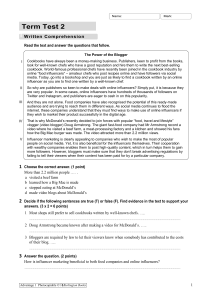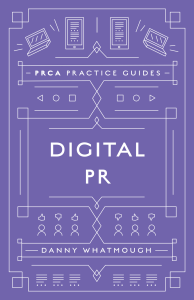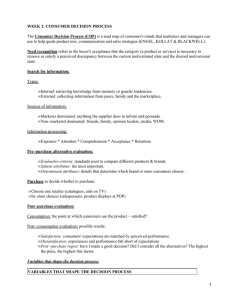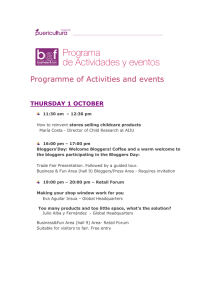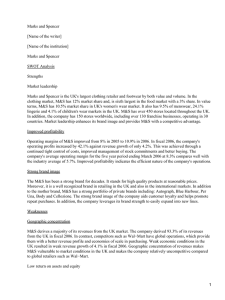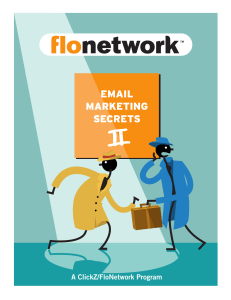why influencers are key to your content marketing
Anuncio
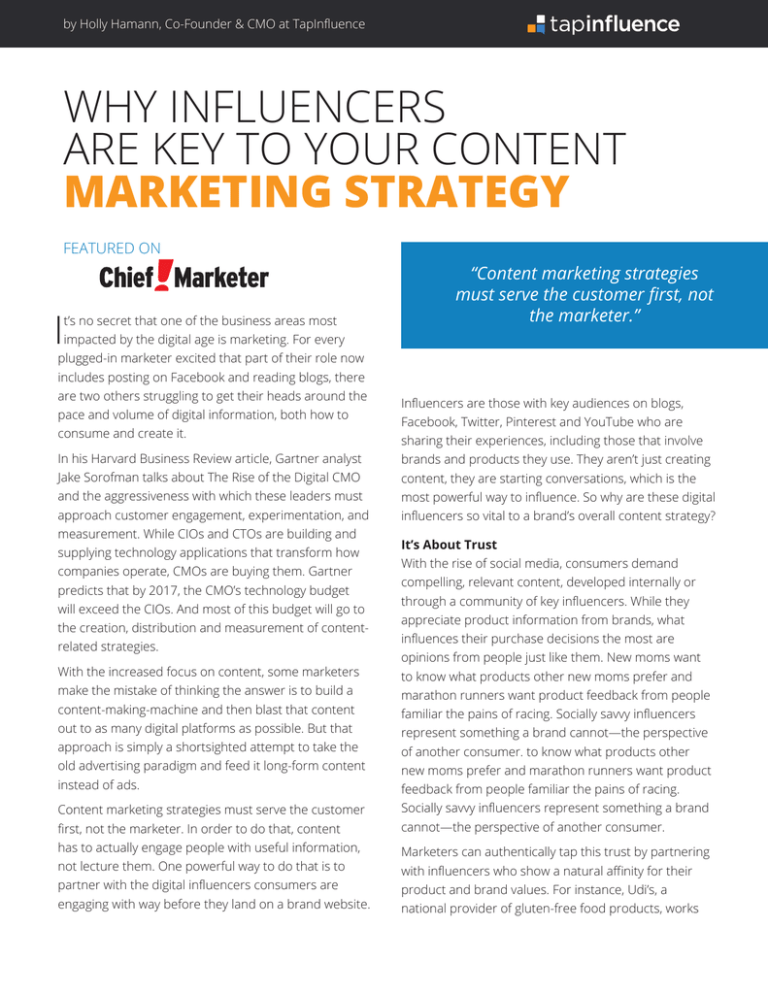
by Holly Hamann, Co-Founder & CMO at TapInfluence WHY INFLUENCERS ARE KEY TO YOUR CONTENT MARKETING STRATEGY FEATURED ON I t’s no secret that one of the business areas most impacted by the digital age is marketing. For every plugged-in marketer excited that part of their role now includes posting on Facebook and reading blogs, there are two others struggling to get their heads around the pace and volume of digital information, both how to consume and create it. In his Harvard Business Review article, Gartner analyst Jake Sorofman talks about The Rise of the Digital CMO and the aggressiveness with which these leaders must approach customer engagement, experimentation, and measurement. While CIOs and CTOs are building and supplying technology applications that transform how companies operate, CMOs are buying them. Gartner predicts that by 2017, the CMO’s technology budget will exceed the CIOs. And most of this budget will go to the creation, distribution and measurement of contentrelated strategies. With the increased focus on content, some marketers make the mistake of thinking the answer is to build a content-making-machine and then blast that content out to as many digital platforms as possible. But that approach is simply a shortsighted attempt to take the old advertising paradigm and feed it long-form content instead of ads. Content marketing strategies must serve the customer first, not the marketer. In order to do that, content has to actually engage people with useful information, not lecture them. One powerful way to do that is to partner with the digital influencers consumers are engaging with way before they land on a brand website. “Content marketing strategies must serve the customer first, not the marketer.” Influencers are those with key audiences on blogs, Facebook, Twitter, Pinterest and YouTube who are sharing their experiences, including those that involve brands and products they use. They aren’t just creating content, they are starting conversations, which is the most powerful way to influence. So why are these digital influencers so vital to a brand’s overall content strategy? It’s About Trust With the rise of social media, consumers demand compelling, relevant content, developed internally or through a community of key influencers. While they appreciate product information from brands, what influences their purchase decisions the most are opinions from people just like them. New moms want to know what products other new moms prefer and marathon runners want product feedback from people familiar the pains of racing. Socially savvy influencers represent something a brand cannot—the perspective of another consumer. to know what products other new moms prefer and marathon runners want product feedback from people familiar the pains of racing. Socially savvy influencers represent something a brand cannot—the perspective of another consumer. Marketers can authentically tap this trust by partnering with influencers who show a natural affinity for their product and brand values. For instance, Udi’s, a national provider of gluten-free food products, works with dozens of bloggers who specifically create and share content about gluten-free recipes and products. Their readers trust their opinions and the products covered and a partnership is win-win-win for the Udi’s, the bloggers and their readers. Influencers Represent the Power of the Middle Finding, engaging and collaborating with influencers used to be a very manual process and only allowed marketers to coordinate and manage the efforts and content of a handful of influencers. That, combined with the assumption that big numbers meant big influence, motivated marketers to just want to work with bloggers and influencers who had high monthly unique visitors or millions of followers on Twitter or YouTube. This meant that the same bloggers ended up working on programs over and over. Those top 5% might represent big numbers, but they don’t necessarily represent the millions of consumers who have targeted needs and therefore follow niche influencers who produce very targeted content. These include marathon runners, cat lovers, military families, cancer survivors and those with allergies or special diets. Collectively, the millions of influencers who cater to these audiences are impacting exponentially more consumers than the top 5%. This is the power of the middle, also known as the “long tail.” Influencers Are Your Content Distribution Army Relevant, meaningful content is wasted if it doesn’t reach or engage a scalable audience. Social media influencers represent a powerful way for marketers to distribute three valuable types of media—paid, earned and owned. Paid media is the coverage you get when you paid for your message to be included or incorporated into published content. Sponsored content that is written by a blogger and paid for by a marketer falls into this category. Earned media is the coverage you get when viewers authentically share brand content and are not compensated. A sponsored post or tweet that is shared by a reader falls into this category. Owned media is the content that lives on a brand’s own digital assets like their corporate blog. There is a dollar value associated with each one of these distribution channels and working with influencers allows marketers to capitalize on all three. As an example, ABC News worked with hundreds of bloggers on a campaign to help raise awareness about issues that affected women and babies around the globe. Their mission was to connect a million mothers in the U.S. with a million moms in developing countries to draw attention to issues like vaccines, prenatal care and the value of quick access to medical care. They worked with a select group of women bloggers who shared their birth and adoption stories and were compensated for their stories (paid media). Thousands of unpaid readers and followers on social sites like Facebook and Twitter shared the stories and commented about their own experiences (earned media). ABC News then curated the stories and hosted them on their own community website, driving even more engagement (owned media). The campaign and its viral distribution created a world-wide social movement that reached millions, resulted in a rally in Times Square that brought together hundreds of NGOs and women from around the world, and won Forrester’s coveted Groundswell Award for its contribution to social good. This was only possible because of the distribution power of influencers and their ability to organically engage a relevant audience. Incorporating influencer marketing should be a critical component to any brand’s content marketing strategy. It is the key to scaling the creation and distribution of stories that are trusted and shared by the consumers they are meant to reach. Want to learn more about how leading brands are influencing their audiences? A TapInfluence brand strategist can help you determine if influencers are a good fit for your content strategy. For more information on finding and utilizing sources for influencer marketing, connect with us online at: www.tapInfluence.com/contact or contact us directly at: [email protected] (720) 726-4074
